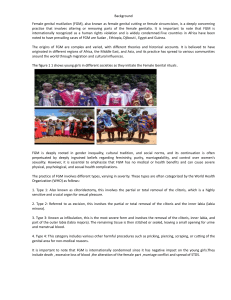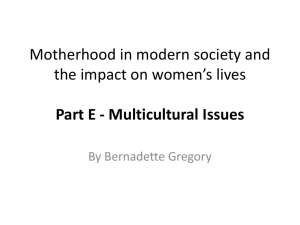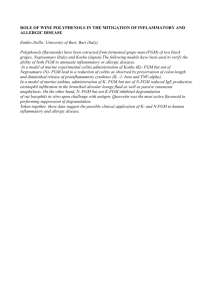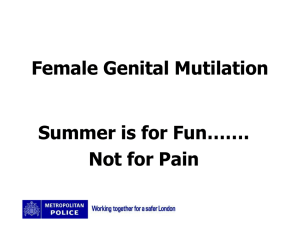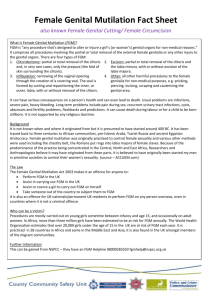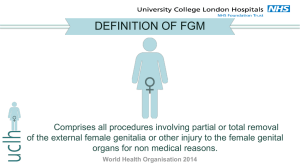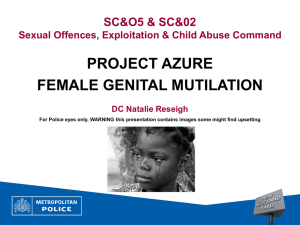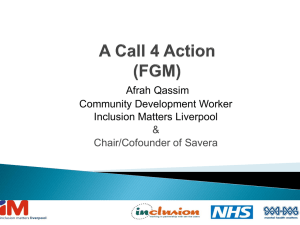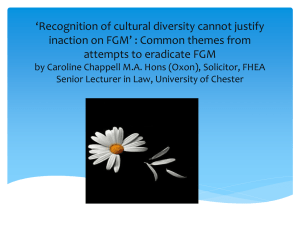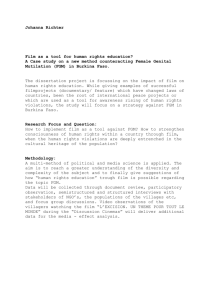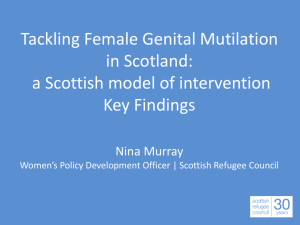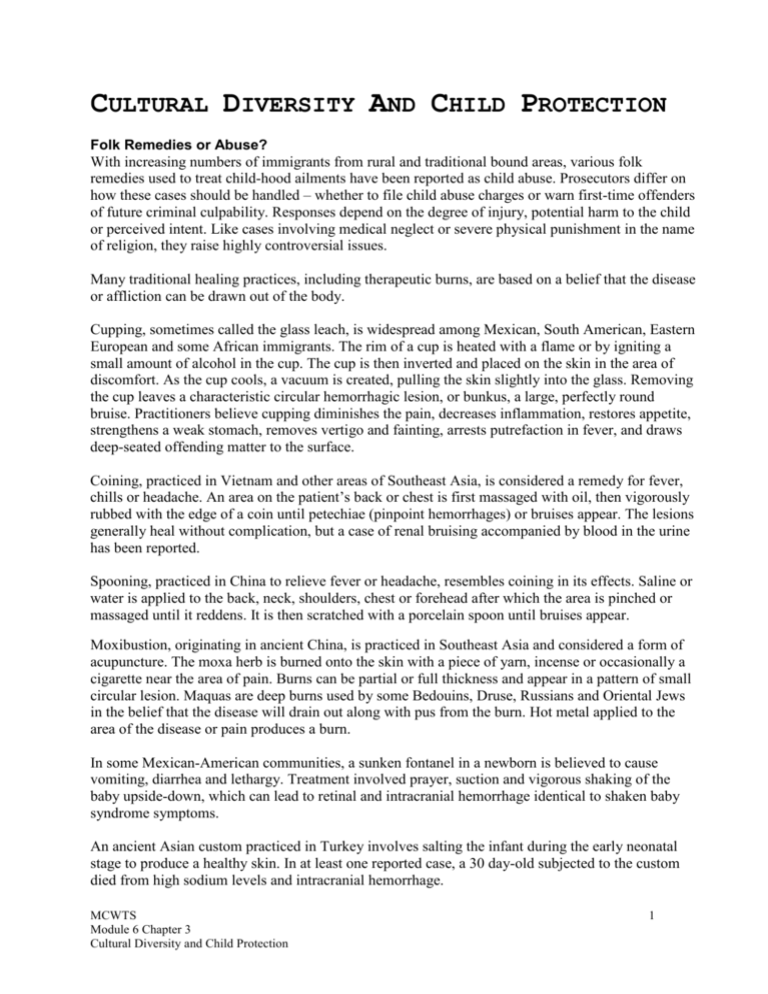
CULTURAL DIVERSITY AND CHILD PROTECTION
Folk Remedies or Abuse?
With increasing numbers of immigrants from rural and traditional bound areas, various folk
remedies used to treat child-hood ailments have been reported as child abuse. Prosecutors differ on
how these cases should be handled – whether to file child abuse charges or warn first-time offenders
of future criminal culpability. Responses depend on the degree of injury, potential harm to the child
or perceived intent. Like cases involving medical neglect or severe physical punishment in the name
of religion, they raise highly controversial issues.
Many traditional healing practices, including therapeutic burns, are based on a belief that the disease
or affliction can be drawn out of the body.
Cupping, sometimes called the glass leach, is widespread among Mexican, South American, Eastern
European and some African immigrants. The rim of a cup is heated with a flame or by igniting a
small amount of alcohol in the cup. The cup is then inverted and placed on the skin in the area of
discomfort. As the cup cools, a vacuum is created, pulling the skin slightly into the glass. Removing
the cup leaves a characteristic circular hemorrhagic lesion, or bunkus, a large, perfectly round
bruise. Practitioners believe cupping diminishes the pain, decreases inflammation, restores appetite,
strengthens a weak stomach, removes vertigo and fainting, arrests putrefaction in fever, and draws
deep-seated offending matter to the surface.
Coining, practiced in Vietnam and other areas of Southeast Asia, is considered a remedy for fever,
chills or headache. An area on the patient’s back or chest is first massaged with oil, then vigorously
rubbed with the edge of a coin until petechiae (pinpoint hemorrhages) or bruises appear. The lesions
generally heal without complication, but a case of renal bruising accompanied by blood in the urine
has been reported.
Spooning, practiced in China to relieve fever or headache, resembles coining in its effects. Saline or
water is applied to the back, neck, shoulders, chest or forehead after which the area is pinched or
massaged until it reddens. It is then scratched with a porcelain spoon until bruises appear.
Moxibustion, originating in ancient China, is practiced in Southeast Asia and considered a form of
acupuncture. The moxa herb is burned onto the skin with a piece of yarn, incense or occasionally a
cigarette near the area of pain. Burns can be partial or full thickness and appear in a pattern of small
circular lesion. Maquas are deep burns used by some Bedouins, Druse, Russians and Oriental Jews
in the belief that the disease will drain out along with pus from the burn. Hot metal applied to the
area of the disease or pain produces a burn.
In some Mexican-American communities, a sunken fontanel in a newborn is believed to cause
vomiting, diarrhea and lethargy. Treatment involved prayer, suction and vigorous shaking of the
baby upside-down, which can lead to retinal and intracranial hemorrhage identical to shaken baby
syndrome symptoms.
An ancient Asian custom practiced in Turkey involves salting the infant during the early neonatal
stage to produce a healthy skin. In at least one reported case, a 30 day-old subjected to the custom
died from high sodium levels and intracranial hemorrhage.
MCWTS
Module 6 Chapter 3
Cultural Diversity and Child Protection
1
This summary was drawn from “Conditions Mistaken for Child Abuse: Part II,” THE PEDIATRIC
TRAUMA AND FORENSIC NEWSLETTER 54 (1996).
Tattooing
While scarification of babies to designate tribal affiliations or geographic origins is practiced but
waning in some cultures, tattooing appears to be on the rise in the US. According to news reports,
jurisdictions have responded differently to parents accused of tattooing their young children.
A Trenton, GA couple was arrested on a misdemeanor offense and released after each posted a
$2,500 bond after tattooing a picture of a wolf’s head on the buttocks of their six year-old daughter –
reportedly for identification purposes. Georgia law prohibits anyone from tattooing the body of a
child under 18 except for a technician acting under the direct supervision of a physician or
osteopath.
In Sidney, NE, a judge dismissed felony child abuse charges against four adults who tattooed their
daughters. The judge said prosecutors failed to show it endangered the girls’ health, deprived them
or care or posed a risk of hepatitis or other disease. Multiple tattoos included five images on a 13
year-old including a heart below her left eye, and crosses on the abdomens of 11 and 12 year-olds.
Cultural Defense
In a recent letter to the Center, Assistant District Attorney, Michele McKay McCoy wrote: Because
Santa Claus has a lot of immigration, we hear the cultural defense frequently. Typically the
defendant says, “I come from _____________ where beating your child is permissible. I had no
idea it was a crime here.” I have heard that defense so far from people who came here from Korea,
the Philip-pines, Vietnam, Cambodia, Laos, Co-lombia, Mexico, Iran, Syria, Ghana, and Kentucky.
Our response in every case is the same, a polite, “So what, it’s a crime here. Welcome to
California, here are the rules. Don’t beat your children.”
NATIONAL CENTER FOR PROSECUTION OF CHILD ABUSE
Female Genital Mutilation
Between 100 million and 130 million women and girls, now living across the world have been
subjected to the ritual of female genital (FGM). The World Health Organization (WHO), which
urges elimination of the practice, estimates that two million girls undergo the procedure each year.
Practiced historically in about 26 African countries and parts of Asia and South America, FGM is
now surfacing in this country among immigrant groups.
An estimated 10,000 girls are currently at risk in the United States. Many will be sent back to their
parents’ country for the procedure. In other communities, residents will share the cost of importing a
midwife to the United States, make arrangements with a local doctor willing to perform the
procedure or do it themselves. Congress has now joined an increasing number of states in banning
the procedure. Bills with similar wording to California’s are before the legislature of other states…
“criminal investigations and prosecutions should be carried out, when necessary, to send a strong
message that California abhors this practice and views its abolition as paramount to the health and
welfare of these young girls.” 1996 Cal. Adv. Legis. Serv. 790 (Deering).
What is FGM? In a very small percentage of cases, the procedure consists of a small cut to the hood
MCWTS
Module 6 Chapter 3
Cultural Diversity and Child Protection
2
of clitoris. This is the only type of FGM to which the term “circumcision” can be accurately applied.
Generally, the procedure involves complete removal of the clitoris and often some of the inner and
outer labia. In the most extreme form of FGM, “infibulation,” almost all of the external genitalia
(labia majora and labia minor) are cut away, scraped to the bone and the remaining flesh of the outer
labia sewn or held together (infibulated) with cat-gut, silk or thorns. The child’s legs are then bound
from ankle to waist for several weeks while scar tissue closes up the vagina almost completely. A
tiny opening, often made by inserting a matchstick, is left for urine and menstrual blood.
Female genital mutilation is generally performed on girls from four to ten but can occur from
infancy to adulthood. In some areas FGM is practiced during the seventh month of a first pregnancy
in the belief the baby will die if it comes in contact with the mother’s clitoris. Traditionally
performed without anesthesia on a child in agony, the procedure is often imprecise. “The pain is
unimaginable,” says Mimi Ramsey, who underwent FGM at ten in Ethiopia and has become an
activist devoted to eradicating the practice.
The immediate physical effects of FGM can and do cause death – in 15% of cases according to a
Kenyan gynecologist. These effects include acute infections, tetanus, bleeding of adjacent organs,
shock resulting from violent pain and hemorrhage. Unsterile instruments such as scissors, knives,
razor blades, broken glass, or even the teeth of the midwife also result in severe medical problems.
Lifelong physical and psychological effects are manifold: chronic pelvic infections and pain,
abscesses, sterility, incontinence, depression and even psychosis, sexual dysfunction and obstetric
complications. On infibulated women, the genital scar must be cut open for sexual penetration to
occur and re-cut when giving birth. One researcher found that 20% of infibulated or excised women
die in childbirth. For the obstructed infant, labor can lead to brain damage or death. Almost all
infibulated girls and women experience the greatly increased time needed to urinate since they can
only urinate drop by drop.
“The purpose is to subjugate women…to make them marriage-able,” says Surita Sadosham, director
of the international women’s rights group Equality Now. Natural protuberances are viewed as ugly –
the accoutrements of prostitutes – and it is often believed that left alone, the clitoris will grow and
drag on the ground. Girls who resist are told they will be ostracized and shame their families.
According to WHO, some women believe clitoridectomy or infibulation are more hygienic and will
increase fertility. Infibulation is also performed to protect lineage by ensuring wives are virgins at
marriage and their children are verifiably the men’s descendants.
The practice of FGM is unlikely to die quickly. Many immigrant parents express strong support for a
practice designed to keep girls chaste in an American culture seen rife with sexual messages and
promiscuity. Ramsey recounts the comments of a man who locked his three year-old in the bedroom
and performed the mutilation. “He said she was too wild…liked to play outside too much. She had
friends who were boys. He said this will tame her.”
California, Rhode Island, Louisiana, Wisconsin, North Dakota, Tennessee, Minnesota and Delaware
have banned FGM, noting that “custom, ritual or standard practice” or consent by the female minor
or her parent cannot be asserted as defenses to prosecution. Colorado, Michigan, New York,
Pennsylvania, New Jersey and Illinois have bills pending to criminalize the procedure. The President
just signed a federal bill criminalizing FGM and directing the INS to inform persons receiving visas
of the potential criminal and civil child abuse sanctions for allowing a child to be subjected to FGM
MCWTS
Module 6 Chapter 3
Cultural Diversity and Child Protection
3
in the United States. (To appear at 18 U.S.C. § 116 (1997). Canada, France, Switzerland, Great
Britain, Sweden, Belgium and Denmark have already outlawed the procedure.
Canada became the first county to label FGM a form of persecution justifying asylum. So far, US
rulings have been inconsistent. In a ruling that set a precedent for US immigration judges, the Board
of Immigration Appeals recently granted political asylum to a 19 year-old who fled to the US to
escape mutilation and was imprisoned while awaiting resolution of her case. Commenting on the
case, INS General Counsel David Martin said: “[Cultural practices] open up a whole new set of
categories that don’t fit easily into those established within the law. The people who perform FGM
don’t do it in order to punish someone. They’re doing it to welcome them into the group or
performing a necessary cultural rite. In our belief, we say that in some situations this should not be
an obstacle to claiming asylum…but it’s a complicated legal question.”
Maybe, maybe not. With increased awareness of the excruciating pain suffered by victims, severe
medical risks and now federal criminal consequences of female genital mutilation, legal questions
surrounding this particular cultural practice may become a lot less complicated for prosecutors.
Taken from “Update,” a publication of the American prosecutors Research Institute’s national Center for
Prosecution of Child Abuse. Volume 9, Numbers 7/8, 1996.
MCWTS
Module 6 Chapter 3
Cultural Diversity and Child Protection
4

